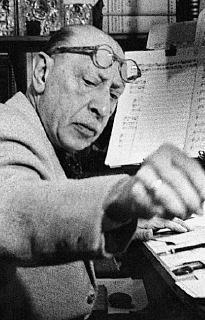Biography
Igor Stravinsky (1882–1971)

The son of an important opera singer, Igor Stravinsky studied law and did not turn seriously to music until he was nineteen. He was fortunate to be able to study with Nikolai Rimsky-
Rimsky’s brand of nationalism served young Stravinsky well in the famous (and still outstandingly popular) ballet scores The Firebird, Petrushka, and The Rite of Spring, which he wrote for the Ballets Russes, a Russian company centered in Paris. This enormously dynamic organization, run by a brilliant producer and man-
After World War I Stravinsky composed more ballets for Diaghilev, as well as other works in a dazzling variety of styles, forms, and genres. One of his most impressive scores, The Wedding, was choreographed by Bronislava Nijinska, Nijinsky’s sister, who was less famous as a dancer than her brother but much better as a choreographer. Among the first classical composers to be interested in jazz, Stravinsky wrote Piano Ragtime in 1917 (and, much later, Ebony Concerto for clarinetist Woody Herman’s jazz band; clarinets are made of ebony). He became an outspoken advocate of “objectivity” in music, the rejection of Romantic emotionality. For many years after World War I he modeled his music on pre-
His final work in this vein was an opera, The Rake’s Progress, which is a kind of modern transformation of Mozart’s Don Giovanni. This was written in America (to English words), where Stravinsky had moved in 1939. After World War II his music grew more abstract and formal in style.
For a quarter of a century people had regarded Stravinsky (and he regarded himself) as the leading Neoclassical composer in the French orbit, at the opposite pole from Schoenberg and the Viennese serialists (see page 327). So he created yet another sensation when, in his seventies, he produced a remarkable group of late compositions employing serial technique. One of the first of these, Agon, was written for the great choreographer George Balanchine of the New York City Ballet, who had worked on Stravinsky’s Neoclassical Apollo twenty-
After some scary stays in American hospitals, on which the composer’s comments were particularly caustic, Stravinsky died at his home in New York in 1971. He is buried in Venice, near the grave of Diaghilev.
Chief Works: Ballet scores, including The Firebird, Petrushka, The Rite of Spring, The Wedding, Orpheus, Agon ◼ The Soldier’s Tale, an unusual chamber-
Encore: After The Rite of Spring, listen to Petrushka and Symphony of Psalms. Read Conversations with Stravinsky by Robert Craft, a protégé of Stravinsky for many years.
Image credit: Sanford Roth/Science Source.